#doria's tree kangaroo
Explore tagged Tumblr posts
Text
Tree Kangaroos and Rufous Bettongs are largely solitary, although they sometimes associate in pairs, trios, or small groups of adults and their young.
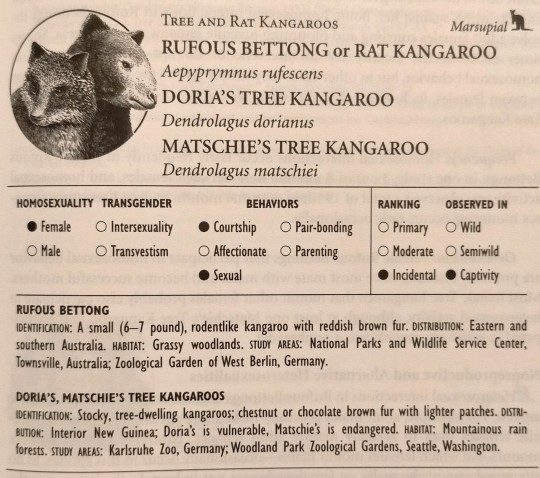
"Biological Exuberance: Animal Homosexuality and Natural Diversity" - Bruce Bagemihl
#book quotes#biological exuberance#bruce bagemihl#nonfiction#rufous bettong#rat kangaroo#aepyprymnus rufescens#doria's tree kangaroo#dendrolagus dorianus#matschie's tree kangaroo#dendrolagus matschiei#solitary#pair#trio#small group
1 note
·
View note
Photo
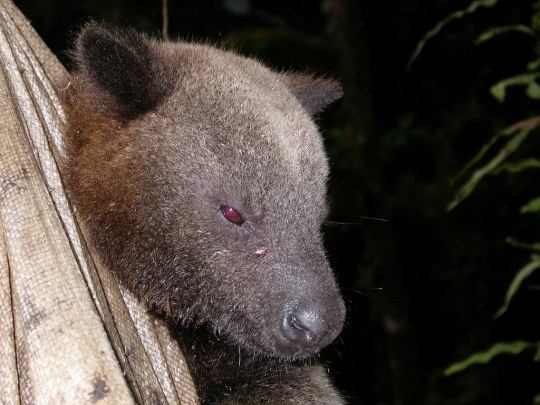
Unicolored tree kangaroo (Dendrolagus dorianus)
Photo by John Slapcinsky
#unicolored tree kangaroo#doria's tree kangaroo#tree kangaroo#dendrolagus dorianus#dendrolagus#macropodinae#macropodidae#macropodoidea#macropodiformes#diprodontia#australidelphia#marsupialia#metatheria#mammalia#tetrapoda#vertebrata#chordata
26 notes
·
View notes
Photo
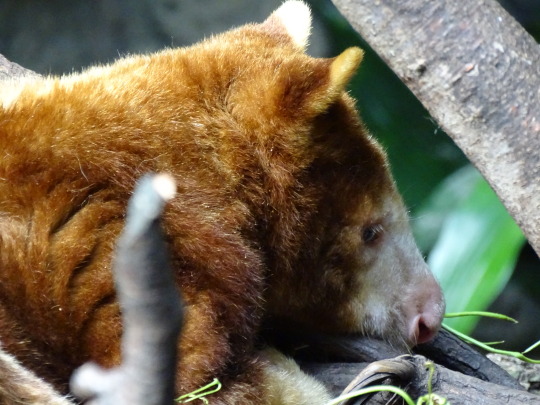
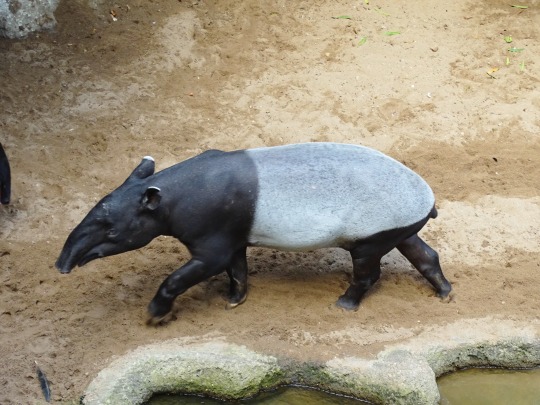


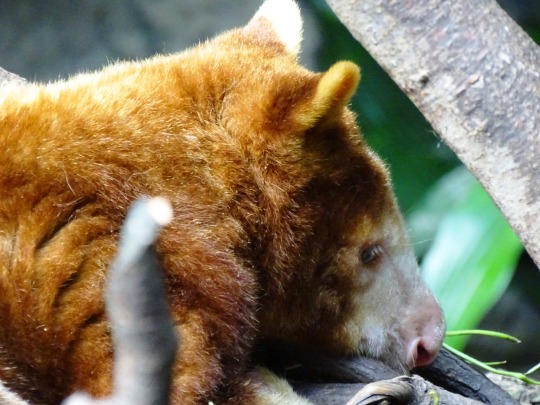

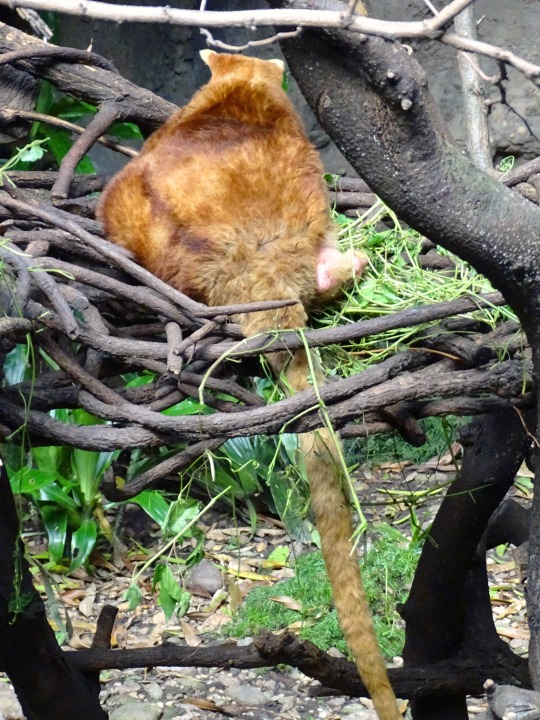



Bronx Zoo, New York City (No. 41)
Matschie's tree-kangaroo (Dendrolagus matschiei), also known as the Huon tree-kangaroo is a tree-kangaroo native to the Huon Peninsula of northeastern New Guinea island, within the nation of Papua New Guinea.
Under the IUCN classification, Matschie's tree-kangaroo is an Endangered species.
The scientific name honours German biologist Paul Matschie.
With a body and head length of 20 to 32 inches (51–81 cm), Matschie's tree-kangaroo are much smaller than Australia's well-known red kangaroo. An adult male weighs between 20 and 25 lb (9–11 kg). An adult female weighs between 15 and 20 lb (7–9 kg)
There is no particular season in which they breed. Gestation lasts 44 days and joeys of captive bred individuals leave the pouch after 11 months. The average life span of the Matschie's tree-kangaroo in the wild is unknown, but is at least 14 years. The life span of the kangaroo in a zoo is about 20 years.
The most distinctive trait of all tree-kangaroos is the hair whorl they possess. It is a patch of hair that goes out in many directions and its location ranges from up near the shoulders all the way down to the tail. The Matschie's tree-kangaroo is golden on its ventral side, lower parts of its limbs, ear edges, belly, and tail, and the rest of its body is a chestnut brown colour, except for usually having a dark stripe down its back. Their faces are typically an array of yellow and white colours. The Matschies’ are similar in colour and size to Dendrolagus dorianus, the Doria's tree-kangaroo. Matschies’ ears are small and bear-like looking and they do not have a good sense of hearing because of it. They have curved claws on their forelimbs and soft pads on their hind limbs that aid in their climbing ability, and they have some independent movement of their digits as well as good dexterity due to their forelimbs being able to bend a great deal. The 4th and 5th digit of their feet are enlarged, the 1st digit is absent, and the 2nd and 3rd digits are syndactylous (two digits that look like one fused together). Scientists have discovered that the Matschie's are able to walk bipedally and there's a lot of rotation in their limbs for climbing. Out of all of the Dendrolagus species, the Matschie's tree-kangaroo is the best vertical climber and has more strength in its muscles than any others. Their tails help to offset their balance while moving swiftly through the trees since their tails are about the same length as their head and body size. Sexual dimorphism is very low, with males and females being of about equal sizes. The upper and lower jaws of the Matschie's tree-kangaroos are different too in addition to them being different in body size. The upper jaw has three incisors, one canine, one premolar, and four molars, while the lower jaw has one very sharp incisor, no canines and low crowned molars.
Source: Wikipedia
#Huon tree-kangaroo#Bronx Zoo#JungleWorld#my favorite zoo#animal#USA#indoors#Total Experience attraction#worth the money#New York City#summer 2018#reptile#sailfin lizard#Malayan tapir#Asian Tapir#landmark#tourist attraction#cityscape#nature#flora#fauna#tree#close up#detail#original photography#Northeastern USA
4 notes
·
View notes
Text
Port Moresby Nature Park
Port Moresby Nature Park
Understandably one of the most popular places in Port Moresby, the Nature Park is the best (or at least the easiest and cheapest by some margin) way to see the incredible native animals of Papua New Guinea up close.
The first enclosure was a converted WW2 structure relocated from downtown Port Moresby. It was home to some of the most colourful birds in the park, such as the Eclectus Parrot,…
View On WordPress
#Agile Wallaby#Bird of Paradise#Blue-king Kookaburra#Cassowary#Dorias Tree Kangaroo#Eclectus Parrot#Grey Dorcopsis Wallaby#Huon Tree-Kangaroo and Goodfellows Tree-Kangaroo#Papua New Guinea#photography#PNG#Port Moresby Nature Park#Purple-bellied Lory#Raggian Bird of Paradise#Rainbow Lorikeet#Slender-billed Cuckoo-Dove#travel#Victoria Crowned Pigeon#Western Black-capped Lory#Yellow-faced Myna
0 notes
Conversation
Favorite Mammals List
Hey guys I figured I should do a favorite mammal based on what group they are in (like wild cats, wild dogs etc) Because lets be honest I love animals and can never choose just one favorite. So yeah lets get started *Warning this is going to be really long AND I'M SORRY I DON'T KNOW WHERE THE PUT UNDER READ MORE IS...t-t. I will do a fav bird, reptile, amphibian and even fish. I won't do invertebrates though as I am scared of 90% of them. But the rest I will do in different posts because it'll get wayyyyy to long.*
Mammals:
Egg-laying mammals: Platypus
Marsupials: Doria's Tree Kangaroo
Insectivores: Western European Hedgehog
Bats: It's a tie between Egyptian Rousette or Rodriguez flying fox.
Lemurs: Ruffed Lemur
Monkeys: Eastern black and white Colobus Monkey
Apes: White-cheeked Gibbon
Anteaters and Relatives: Southern tamandua
Rabbits: Arctic Hare
Squirrel-like Rodents: Indian Giant Squirrel
Mouselike Rodents: Striped Grass Mouse
Cavylike Rodents: It's a tie between Chinchilla and Capybara BECAUSE I JUST LOVE BOTH OF THOSE SO MUCH.
Baleen Whales: Blue Whale
Toothed Whales: Bottlenose Dolphin
Dogs and Relatives: Fennec Fox
Bears: Giant Panda
Raccoons and Relatives: Red Panda
Mustelids: Ermine
Otters: (which get their own category even though it's in the mustelids family): Giant Otters (CAUSE THOSE THINGS ARE MASSIVE they grow to like 4 feet long)
Civets and Relatives: Meerkat
Hyenas and Aardwolf: Spotted Hyena
Cats: Leopard
Seals and Sea Lions: Harp Seal
Elephants: African Elephant
Horses and Relatives: Prezewalski's wild horse
Rhinos: It's a tie between white rhino or black rhino.
Tapirs: Malayan Tapir
Pigs: RED RIVER HOGS GOSH I LOVE THOSE GUYS
Camels and Relatives: Alpaca (since Alpaca's relative is Vicuna and that is in the same family)
Deer: Caribou
Cattle and Relatives: Bongo and Gerenuk
Domestic Cat: Birman
Domestic Dog: Shetland Sheepdog
And yes I did use my animal dictionary as a guide for this. Next up is Birds :)
1 note
·
View note
Text
ECOCORE The Queer Issue

cover 1: Exene Karros @donaldtrompeloeil
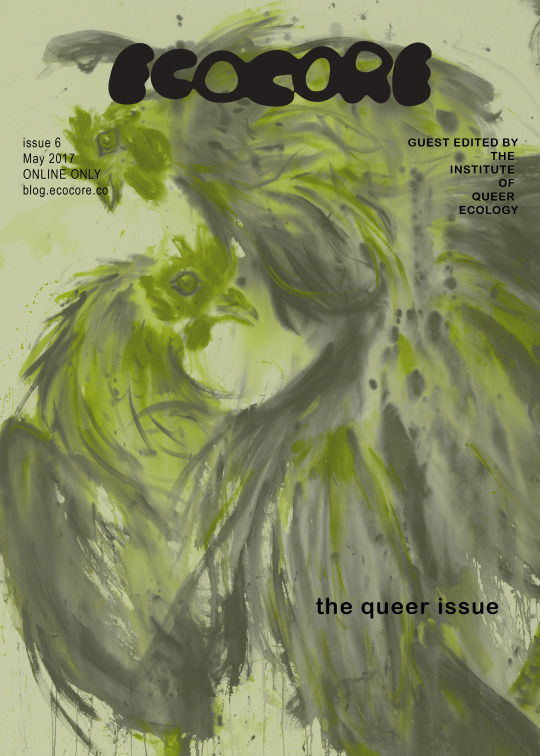
cover 2: Andrej Dubravsky @andrej_dubravsky

cover 3: Caspar Jade Heinemann @angstravaganza
ECOCORE is proud to announce issue 6, an online only issue dedicated to queer strategies in nature. Following the US withdrawal from the Paris Climate Agreement it is urgent to find new approaches to ecology and environmentalism. Starting today @ blog.ecocore.co
Queerness is not yet here. Queerness is an ideality. Put another way, we are not yet queer. We may never touch queerness, but we can feel it as the warm illumination of a horizon imbued with potentiality. We have never been queer, yet queerness exists for us as an ideality that can be distilled from the past and used to imagine a future. -José Esteban Muñoz, Cruising Utopia: The Then and There of Queer Futurity Ecocore’s sixth issue, The Queer Issue, guest edited by The Institute of Queer Ecology (IQECO), operates at the intersection of queer and environmental discourse, with a mission to improve both fields. Each movement, perpetually evolving though not fast enough, benefits from being in conversation with the other. Yesterday I found myself at one of the last shows of the Ringling Bros. and Barnum & Bailey Circus, in Providence, Rhode Island. I had just left a meeting with two other members of IQECO, where we discussed the types of invisible labor being done by plankton (plus other microbial Foundation Species) and queer (human) communities. When I arrived at the circus, then, I found myself still burdened with criticality. When the lights went out and spotlights hit a cage in the center of the arena, 12 tigers were sitting on stools and I braced myself for an unnerving show. A large man with dueling whips lashed the tigers, ordering the cats to jump, roar, stand, and move about. I sank lower into my chair, feeling rather microbial as a crowd of thousands clapped and screamed in excitement at the spectacle of human supremacy. Earlier, as the National Anthem had boomed, a lesbian couple sat down next to me and I let out a sigh of relief. The three of us would form an instant unspoken alliance for the next 3 hours, silently critiquing the The Greatest Show on Earth. So when the 12 tigers began leaping in fear of a man who commanded them and the audience into a frenzy, I looked towards my newfound queer sisters. I was disappointed to see that they too were cheering, hand in hand. I lay out this anecdote to highlight the dangerous rift still standing between queer and environmental justice. I expected the couple next to me to naturally align themselves with the subjugated tigers, rather than with oppressive man. But as critical conversations about ecology and queerness are still far from the mainstream, this way of thinking takes time and dedication. Eventually, I believe it will prove incredibly helpful for both the lgbt+ community and the natural world. This new alignment allows queer individuals to find kin with any oppressed species, many of which are queerer than we imagined. While tigers have not yet been observed to engage in homosexual behavior, at least another 1,500 species have, including lions, where homosexual and trans individuals have been recorded. Our simplified collective understanding of human gender and sexuality collapses on itself when we are confronted by a fungus with 28,000 sexes. Catriona Sandilands states (while discussing the works of Elizabeth Wilson and Myra Hird) that “nonhuman sexual and gender diversity both calls into question human exceptionalism and destabilizes notions of identity, authenticity, and technology on which modern categories of human sexual orientation rest.” The research is overwhelming and powerful, as exemplified by the enduring influence of Bruce Bagemihl’s seminal text, Biological Exuberance. Bagemihl’s book about animals with homosexual tendencies was used as evidence by the American Psychiatric Association before the US Supreme Court in Lawrence v. Texas, a case that ultimately struck down sodomy laws in 14 states. The Queer Issue presents IQECO’s inaugural attempt to present a sliver of this growing body of research, as well as works by artists that consider this hybridized way of thinking. The Queer Issue is assembled eclectically, with republished texts by Bruce Bagemihl that have heavily influenced the field, as well as original commissions for the occasion of this issue. Liby Hays will present a collection of four poems from the perspective of a Trans Termite Queen. Briohny Walker will contribute a new paper on an ethics of failure and futurelessness. Greta Skagerlind invites you to contribute to their ever-growing in-flux definition of Queer Design Principles via a collaborative google doc. Ryan Hammond will talk about their ongoing work, Open Source Gender Codes, which attempts to queer current regimes of pharmaceutical production and systems of ownership by producing open source hormone production protocols. Ecocore and IQECO welcome you to The Queer Issue. Edited by Lee Pivnik for the Institute of Queer Ecology Bruce Bagemihl Urban Barnyard Alessandro Bava Andrej Dubravsky Ryan Hammond Liby Hays Caspar Heinemann Alex Ju Exene Karros Les U. Knight / VHEMT Lee Pivnik Isabella Rossellini Jack Schneider Greta Skagerlind Briohny Walker Additionally, we would like to out our non-human contributors. The following is a list of animals that have been recorded exhibiting either homosexual or transgender behavior, assembled by Bagemihl in his 1999 publishing of Biological Exuberance. Their vibrant and diverse existence reminds us with force that we are not alone in our queerness, but should our species continue to encroach on their habitats, we may find ourselves increasingly lonesome. Acorn Woodpecker Addax Antelope Adelie Penguin African Buffalo African Elephant African jacana African swallowtail butterfly Agile Wallaby akepa Allen hummingbird Amazon Molly Amazon River Dolphin see Boto American Bison American kestrel angelfish Anna’s Hummingbird ant Aoudad Aperea arctic tern Asiatic Elephant Asiatic Mouflon Atlantic Spotted Dolphin Australian noisy miner Australian raven Australian Sea Lion Australian Shelduck avocet Aztec Parakeet badger Bank Swallow Barasingha Barbary Sheep Barn Owl barn swallow bat bearded seal beaver Beluga Bengalese Finch (Domestic) bewick’s swan Bezoar Bharal Bicolored Antbird Bighorn Sheep bird of paradise black-and-white warbler Black Bear Black-billed Magpie Blackbuck black-capped chickadee black-capped lorikeet Black-crowned Night Heron Black-footed Rock Wallaby black-headed grosbeak Black-headed Gull Black-rumped Flameback Black Stilt Black Swan Black-tailed Deer black-tailed gull black-tailed prairie dog Black-winged Stilt Blue-backed Manakin Blue-bellied Roller blue-billed duck bluebird bluejay Blue Sheep see Bharal bluethroat Blue Tit Blue-winged Teal boat-tailed grackle Bonnet Macaque Bonobo Boto Bottlenose Dolphin bowerbird Bowhead Whale Bridled Dolphin Brown Bear see Grizzly Bear brown booby Brown Capuchin Brown-headed Cowbird Brown Long-eared Bat brown noddy Brown Rat Budgerigar (Domestic) Buff-breasted Sandpiper bufflehead duck burro Bush Dog butterfly Calfbird California Gull California sea lion Canada Goose canary Canary-winged Parakeet Caribou Caspian Tern cassowary Cat (Domestic) Cattle (Domestic) Cattle Egret centipede Chaffinch Cheetah Chicken (Domestic) Chiloe Wigeon chimney swift Chinese water deer clapper rail Cliff Swallow Collared Peccary Commerson’s Dolphin Common Brushtail Possum Common Chimpanzee Common Dolphin Common Garter Snake Common Gull Common Marmoset Common Murre Common Pipistrelle Common Raccoon Common Shelduck Common Tree Shrew coral goby cormorant Costa’s hummingbird cottontail rabbit Cotton-top Tamarin coyote coypu Crab-eating Macaque crane crane fly Crane spp. Crested Black Macaque crow Cui curlew cutworm Dall’s Sheep see Thinhorn Sheep Damaraland mole-rat Daubenton’s Bat Dayak fruit bat Desert Tortoise dipper Dog (Domestic) Doria’s Tree Kangaroo dragonfly Dragonfly spp. Dugong Dusky Moorhen Dwarf Cavy Dwarf Mongoose eagle earthworm Eastern Bluebird Eastern Cottontail Rabbit Eastern Gray Kangaroo echidna Egyptian Goose eider duck Eleanora’s falcon Elegant Parrot Elk see Wapiti emperor penguin Emu Euro European Bison see Wisent European jay European Shag falcon Fallow Deer False Killer Whale Fat-tailed Dunnart finch Fin Whale firefly fisher Flamingo fox fox squirrel frog, poisonous fruit bat Fruit Fly spp. fulmar Galah garter snake gecko Gelada Baboon Gentoo Penguin giant cowbird giant river otter Giraffe glaucous-winged gull Goat (Domestic) Golden Bishop Bird golden eagle golden lion tamarin Golden Monkey Golden Plover Gorilla Grant’s Gazelle Gray-breasted Jay Gray-capped Social Weaver gray-cheeked mangabey Gray-headed Flying Fox Gray Heron Gray Seal Gray Squirrel Gray Whale great bustard Great Cormorant great crested flycatcher great egret Greater Bird of Paradise greater painted-snipe Greater Rhea great tit Green Sandpiper Greenshank Greylag Goose Griffon Vulture Grizzly Bear grouper grouse Guianan Cock-of-the-Rock Guillemot see Common Murre Guinea Pig (Domestic) Hamadryas Baboon hamlet Hammerhead Hamster (Domestic) Hanuman Langur Harbor Porpoise Harbor Seal hare Harris’s hawk Harris’s sparrow hawk hawkmoth hedgehog heron Herring Gull Himalayan Tahr Hoary-headed Grebe Hoary Marmot honeybee hooded pitohui Hooded Warbler Horse (Domestic) house martin House Sparrow Humboldt Penguin humbug damselfish humpback whale hyena Indian Fruit Bat Indian Muntjac Indian Rhinoceros Ivory Gull jabiru stork jacana Jackdaw jackrabbit Japanese Macaque Japanese sea raven Javan wart snake Javelina see Collared Peccary jellyfish kalanga parrot Kangaroo Rat kentish plover Kestrel Killer Whale king bird of paradise King Penguin kit (blue) fox Kittiwake kiwi Koala Kob lantern bass lantern fish Lapland longspur lapwing Larga Seal see Spotted Seal Laughing Gull Laysan Albatross Least Chipmunk Lechwe lemming lesser black-backed gull Lesser Bushbaby Lesser Flamingo lesser kestrel Lesser Scaup Duck lesser yellowlegs Lion Lion-tailed Macaque Lion Tamarin Little Blue Heron Little Brown Bat Little Egret Livingstone’s Fruit Bat Long-eared Hedgehog Long-footed Tree Shrew Long-legged Fly spp. long-tailed duck Long-tailed Hermit Hummingbird long-tailed manakin loon lorikeet lucifer hummingbird lunulated antbird magnificent hummingbird Mallard Duck marabou stork marbled murrelet Markhor marmoset marsupial mouse Marten sp. Masked Lovebird Matschie’s Tree Kangaroo Mazarine Blue Mealy Amazon Parrot Mew Gull see Common Gull Mexican Jay see Gray— breasted Jay mink Mocó Mohol Galago see Lesser Bushbaby mole mole-rat mole-vole Monarch Butterfly monitor lizard Montagu’s harrier Moor Macaque Moose moth Mountain Goat mountain lion Mountain Tree Shrew Mountain Zebra Mule Deer murre Mustached Tamarin mustached warbler Musk Duck Musk-ox Mute Swan naked mole-rat natal robin Natterer’s Bat New Zealand fur seal New Zealand Sea Lion nightjar Nilgiri Langur Noctule North American Porcupine Northern Elephant Seal Northern Fur Seal northern jacana northern lapwing Northern Quoll northern rough-winged swallow Ocellated Antbird Ocher-bellied Flycatcher Olympic Marmot one-wattled cassowary opossum Orange Bishop Bird Orange-fronted Parakeet Orang-utan Orca see Killer Whale oriole Ornate Lorikeet osprey Ostrich owl oyster
1 note
·
View note
Photo

Doria’s tree-kangaroo (Dendrolagus dorianus)
Photo by Miriam Silverstein
#captive animal#doria's tree kangaroo#unicolored tree kangaroo#tree kangaroo#dendrolagus dorianus#dendrolagus#macropodinae#macropodidae#macropodoidea#macropodiformes#diprodontia#australidelphia#marsupialia#metatheria#mammalia#tetrapoda#vertebrata#chordata
11 notes
·
View notes
Photo

Doria’s tree-kangaroo (Dendrolagus dorianus)
Art by Peter Schouten
#doria's tree kangaroo#unicolored tree kangaroo#tree kangaroo#dendrolagus dorianus#dendrolagus#macropodinae#macropodidae#macropodoidea#macropodiformes#diprodontia#australidelphia#marsupialia#metatheria#mammalia#tetrapoda#vertebrata#chordata
5 notes
·
View notes
Photo



Doria’s tree-kangaroo (Dendrolagus dorianus) Also known as: Unicolored Tree Kangaroo
Doria’s tree-kangaroo is one of the largest tree-kangaroo species, and weighs 6.5–14.5 kg, its length is 51–78 cm, with a long 44–66 cm tail. It has long dense brown fur with black ears and a pale brown or cream nonprehensile tail. This marsupial is found only in montane forests of southeastern New Guinea island. The species was named in 1883 by Edward Pierson Ramsay in honour of Italian zoologist Giacomo Doria. Its diet consists of various leaves, buds, flowers and fruits. The gestation period is about 30 days, after which, the single young remains in the mother’s pouch for up to 10 months. Its forest habitat is threatened by logging and forest clearance. Being large sized, it’s also hunted for its meat.
Classification: Animalia - Chordata - Mammalia - Metatheria - Marsupialia - Australidelphia - Diprotodontia - Macropodiformes - Macropodoidea - Macropodidae - Macropodinae - Dendrolagus - D. dorianus
Images: [x] [x] [x] Source: [x]
#doria's tree kangaroo#unicolored tree kangaroo#tree kangaroo#dendrolagus dorianus#dendrolagus#macropodinae#macropodidae#macropodoidea#macropodiformes#diprodontia#australidelphia#marsupialia#metatheria#species feature#mammalia#tetrapoda#vertebrata#chordata
2 notes
·
View notes